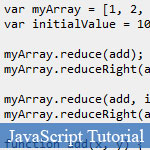 Bài viết này cung cấp cho bạn các hướng dẫn, thủ thuật và các hàm để xử lí các đối tượng mảng JavaScript nâng cao cùng với các mã nguồn JavaScript minh họa đơn giản. Các hàm được hướng dẫn trong bài viết này là
Bài viết này cung cấp cho bạn các hướng dẫn, thủ thuật và các hàm để xử lí các đối tượng mảng JavaScript nâng cao cùng với các mã nguồn JavaScript minh họa đơn giản. Các hàm được hướng dẫn trong bài viết này là forEach, filter, every, some, map, reduce.
Bạn vui lòng vào trang trong để xem chi tiết hoạt xem thêm.
- Demo
- Phóng to
- Tải lại
- Cửa sổ mới
Miễn phí web hosting 1 năm đầu tại iPage
Nếu bạn vẫn còn đang tìm kiếm một nhà cung cấp hosting đáng tin cậy, tại sao không dành chút thời gian để thử với iPage, chỉ với không quá 40.000 VNĐ/tháng, nhưng bạn sẽ được khuyến mãi kèm với quà tặng trị giá trên 10.000.0000 VNĐ nếu thanh toán cho 24 tháng ~ 900.000 VNĐ?
Có trên 1 triệu khách hàng hiện tại của iPage đã & đang hài lòng với dịch vụ, tuyệt đối chắc chắn bạn cũng sẽ hài lòng giống họ! Quan trọng hơn, khi đăng ký sử dụng web hosting tại iPage thông qua sự giới thiệu của chúng tôi, bạn sẽ được hoàn trả lại toàn bộ số tiền bạn đã sử dụng để mua web hosting tại iPage. Wow, thật tuyệt vời! Bạn không phải tốn bất kì chi phí nào mà vẫn có thể sử dụng miễn phí web hosting chất lượng cao tại iPage trong 12 tháng đầu tiên. Chỉ cần nói chúng tôi biết tài khoản của bạn sau khi đăng ký.
Nếu muốn tìm hiểu thêm về ưu / nhược điểm của iPage, bạn hãy đọc đánh giá của ChọnHostViệt.com nhé!
Till recently I always used a for-loop when I had to iterate over an array in JavaScript. For example:
var myArray = [1, 2, 3, 4];
for (var i = 0; i < myArray.length; i++) {
console.log(myArray[i]);
}
However, with ECMAScript 5 the Array object itself got some methods for iteration purposes. With those methods you often can write cleaner code than by using a for-loop. Let�s have a (short) look at those methods. For details, please follow the provided links.
forEach
The forEach() method calls the provided function for each array element. Using forEach(), we can rewrite the example from above to:
var myArray = [1, 2, 3, 4];
myArray.forEach(function (element) {
console.log(element);
});
filter
The filter() method applies the provided filter function to each array element and returns a new array with all elements for which the filter function returned a true value.
For example, to get only the even numbers of an array we could write the following code:
var myArray = [1, 2, 3, 4];
var evenNumbers = myArray.filter(function (x) {
return x % 2 == 0;
});
// evenNumbers is [2, 4]
every & some
The every() and some() methods are similar: whereas the every() method only returns true if the provided testing function returns a true value for each array element, the some() method returns true if there is at least one array element for which the testing function returns a true value. You can see the difference in this example:
var oddNumbers = [1, 3, 5, 7];
var mixedNumbers = [1, 2, 3, 4];
var evenNumbers = [2, 4, 6, 8];
oddNumbers.every(isEven); // returns false
oddNumbers.some(isEven); // returns false
mixedNumbers.every(isEven); // returns false
mixedNumbers.some(isEven); // returns true
evenNumbers.every(isEven); // returns true
evenNumbers.some(isEven); // returns true
function isEven(x) {
return x % 2 == 0;
}
map
The map() method applies the provided function to each array element and returns an array with the results.
For example, to square all values of an array we can do the following:
var myArray = [1, 2, 3, 4];
var squared = myArray.map(function (x) {
return x * x;
});
// squared is [1, 4, 9, 16]
reduce & reduceRight
The reduce() and reduceRight() methods reduce an array step-by-step to a single value by using the provided function and an optional initial value. It works in the following way: the first two array elements (or the initial value and the first array element) are passed as parameters to the provided function. The result of this function call plus the next array element are then used as new parameters for the function. And so on, until there are no more array elements left.
The difference between reduce() and reduceRight() is that reduce() iterates over the array from left-to-right whereas reduceRight() iterates in the opposite direction, from right-to-left.
Here is a simple example to calculate the sum of the values of an array:
var myArray = [1, 2, 3, 4];
var initialValue = 10;
myArray.reduce(add); // performs 1 + 2 + 3 + 4 and returns 10
myArray.reduceRight(add); // performs 4 + 3 + 2 + 1 and returns 10
myArray.reduce(add, initialValue); // performs 10 + 1 + 2 + 3 + 4 and returns 20
myArray.reduceRight(add, initialValue); // performs 10 + 4 + 3 + 2 + 1 and returns 20
function add(x, y) {
return x + y;
}
That�s it. I hope I could give you an overview over the available iteration possibilities in JavaScript. Happy coding!
Update 2011-04-02: I found a site by Microsoft where you can test those methods in your browser: ECMAScript 5 Arrays
- Lượt gửi (0)
- Mới
Save up to 630$ when buy new iPhone 15
GateIO.gomymobi.com
Free Airdrops to Claim, Share Up to $150,000 per Project
https://tooly.win
Open tool hub for free to use by any one for every one with hundreds of tools
chatGPTaz.com, chatGPT4.win, chatGPT2.fun, re-chatGPT.com
Talk to ChatGPT by your mother language
Dall-E-OpenAI.com
Generate creative images automatically with AI
AIVideo-App.com
Render creative video automatically with AI






 30/11/2011
30/11/2011 0
0
